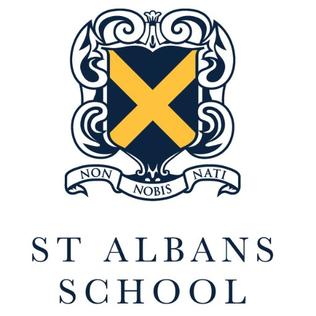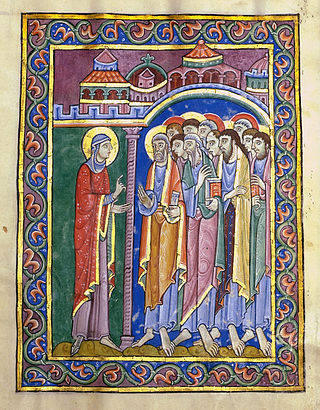Related Research Articles
Thomas Walsingham was an English chronicler, and is the source of much of the knowledge of the reigns of Richard II, Henry IV, Henry V and the latter reign of Edward III depicting the decline of the state of affairs of the English. He also documented the careers of John Wycliff and Wat Tyler.

John Feckenham O.S.B., also known as John Howman of Feckingham and later John de Feckenham or John Fecknam, was an English churchman, the last abbot of Westminster.

John Dunstaple was an English composer whose music helped inaugurate the transition from the medieval to the Renaissance periods. The central proponent of the Contenance angloise style, Dunstaple was the leading English composer of his time, and is often coupled with William Byrd and Henry Purcell as England's most important early music composers. His style would have an immense influence on the subsequent music of continental Europe, inspiring composers such as Du Fay, Binchois, Ockeghem and Busnois.

John Capgrave was an English historian, hagiographer and scholastic theologian, remembered chiefly for Nova Legenda Angliae. This was the first comprehensive collection of lives of the English saints.
William Rishanger, nicknamed "Chronigraphus", was an English annalist and Benedictine monk of St. Albans. Rishanger quite likely wrote the Opus Chronicorum, a continuation from 1259 of Matthew Paris's Chronicle. In effect it is a history of his own times from 1259 to 1307, a spirited and trustworthy account, albeit in parts not original. He wrote a history of the reign of Edward I of England, and a work on the Barons' War; and was probably the continuator of Gesta Abbatum Monasterii Sancti Albani.

St Albans School is a public school in the city of St Albans in Hertfordshire. Entry before Sixth Form is for boys only, but the Sixth Form has been co-educational since 1991. Founded in 948 by Wulsin, St Albans School is not only the oldest school in Hertfordshire but also one of the oldest in the world. The school has been called "Britain's oldest public school" by the Daily Mail. Nicholas Carlisle, in 1818, described the school as "of very ancient origin, and of great celebrity" and the Good Schools Guide describes St Albans as a "traditional public school, with a rich history".
William of Wallingford was the 47th abbot of St Albans Abbey. He was a Benedictine monk at Holy Trinity Priory, Wallingford, Berkshire, England and like John of Wallingford and Richard of Wallingford, moved from this cell of St Albans Abbey to the abbey itself. He was a favourite of John Stoke, 44th abbot of St Albans, also from Wallingford. On his deathbed in 1451, Stoke was supposed to have given William and Thomas Wallingford, his senior chaplain, charge over 1000 marks but after his death they could only account for 250 marks. The abbot John Wheathampstead who succeeded Stoke suspected the two over the money. Nevertheless, William of Wallingford was later appointed abbot in 1476, after the death of William Albone, apparently for his financial acumen, at a time when the abbey was in debt. William of Wallingford managed to get rid of the debt whilst also spending on the abbey. He built the high altar known as the Wallingford Screen at a cost of £733 and completed the chapter house. The statues on it were destroyed during the Dissolution but were replaced in Victorian times.

The Abbot and then Commendator of Melrose was the head of the monastic community of Melrose Abbey, in Melrose in the Borders region of Scotland. The abbots of the earlier Northumbrian foundation from Lindisfarne are not included here. The second abbey was founded in 1136 on the patronage of David I, King of Scots, by Cistercian monks from Rievaulx Abbey, Yorkshire. Control of the abbey was secularized in the 16th century and after the accession of James Stewart, the abbey was held by commendators. The last commendator, James Douglas of Lochleven, resigned the abbacy to William Douglas, 6th Earl of Morton in December 1606, and the abbey itself to the king in 1608. The abbey was then erected into a secular lordship for viscount Haddington, John Ramsay, who in 1609 was created "Lord Melrose". Lochleven however resumed the title of commendator in 1613 until his death in 1620.
John of Trokelowe was an English chronicler and Benedictine monk of the fourteenth century. He was a monk of St Albans Abbey, and in 1294 was living in the dependent priory of Tynemouth, Northumberland. Once he was thought to be a significant chronicler, on the basis of internal evidence; it is now considered very possible that he was merely the scribe for William Rishanger.

Robert King was an English churchman who became the first Bishop of Oxford.

Paul of Caen was a Norman Benedictine monk who became fourteenth Abbot of St Albans Abbey in 1077, a position he held to 1093. He was a nephew of Archbishop Lanfranc.

The St Albans Psalter, also known as the Albani Psalter or the Psalter of Christina of Markyate, is an English illuminated manuscript, one of several psalters known to have been created at or for St Albans Abbey in the 12th century. It is widely considered to be one of the most important examples of English Romanesque book production; it is of almost unprecedented lavishness of decoration, with over forty full-page miniatures, and contains a number of iconographic innovations that would endure throughout the Middle Ages. It also contains the earliest surviving example of French literature, the Chanson de St Alexis or Vie de St Alexis, and it was probably commissioned by an identifiable man and owned by an identifiable woman. Since the early 19th century it has been owned by the church of St. Godehard in Hildesheim, Lower Saxony in northwestern Germany, but is now stored and administered at the nearby Dombibliothek in Hildesheim Cathedral. A single leaf from the manuscript is at the Schnütgen Museum, Cologne; one further leaf, and one further cutting, are missing from the volume, their whereabouts unknown.
This is a list of abbots of St Albans Abbey up to its Dissolution in 1539.
- Willegod (793–796)
- Eadric
- Wulsig
- Wulnoth (Walworth)
- Eadfrith
- Wulsin
- Aelfric
- Ealdred
- Eadmer
- Leofric
- Ælfric of Abingdon
- Leofstan
- Frithric (Frederic)
- Paul of Caen (1077–1093)
- Richard d'Aubeney (1097–1119)
- Geoffrey of Dunstable (1119–1146)
- Ralph Gubion (1146–1151)
- Robert de Gorron (1151–1166)
- Symon (1167–1183)
- Warin (1183–1195)
- John de Cella (1195–1214)
- William of Trumpington (1214–1235)
- John of Hertford (1235–1263)
- Roger de Norton (1263–1291)
- John of Berkhamsted (1291-1302)
- John de Maryns (1302–1308)
- Hugh of Eversden (1308–1327)
- Richard of Wallingford (1326–1335)
- Michael of Mentmore (1335–1349)
- Thomas de la Mare (1349–1396)
- John de la Moote (1396–1401)
- William Heyworth (1401–1420)
- John of Wheathampstead (1420–1440)
- John Stoke (1440–1451)
- John of Wheathampstead (1451–1465)
- William Albon (1465–1475)
- William of Wallingford (1476–1492)
- Thomas Ramryge (1492–1520)
- Thomas Wolsey (1521-1529/1530), Commendatory abbot
- Robert Catton (1529–1538)
- Richard Boreman alias Stevenage (1538–1539), last abbot

Geoffrey de Gorham, sometimes called Geoffrey of Dunstable or of Le Mans, was a Norman scholar who became Abbot of St Albans Abbey, 1119 to 1146.
The St Albans Press was the third printing press set up in England, in 1479. It was situated in the Abbey Gateway, St Albans, a part of the Benedictine Monastery of St Albans. The name of the printer is unknown, only referred to by Wynkyn de Worde in a reprinting of one of the St Albans books as 'Sometime schoolmaster'. He has sometimes been identified as John Marchall, master of St Albans School; however, a passage written by Worde in 1497 implies that the printer was deceased, and Marchall is known to have lived until 1501. Recent research has produced the name John Haule as a possible candidate for the Schoolmaster Printer. He presented the school with its first printed textbook, the Elegantiolae, which was the first book printed at the press, and he was a printer, probably in St Albans in 1479.
Henry Thomas Riley was an English translator, lexicographer, and antiquary.
John Westwyk was an English astronomer, adventurer, Benedictine monk, and author of the Equatorie of the Planetis.
William Binham was an English theologian and Benedictine prior of Wallingford in Berkshire. He took the degree of D.D. at Oxford, where he was for a time intimate with Wycliffe, against whom he afterwards wrote Contra Positiones Wiclevi.
Simon Binham or Bynham was an English chronicler and Benedictine monk of the priory of Binham, Norfolk. He assisted the prior of Binham in opposing the exactions of Hugh, abbot of St. Albans, and was imprisoned for some time with the other rebellious monks. He is said to have contributed to the continuation of the Chronicle of Rishanger, but his other writings are largely lost.
Henry (de) Blaneforde or Blankfrount was an English chronicler and a Benedictine monk of St. Albans. He wrote a short continuation of the chronicle of Trokelowe for the years 1323 to 1324.
References
- ↑ Hicks 1991.
- 1 2 3 4 Chisholm 1911, p. 586.
- ↑ Chisholm 1911, p. 587.
- ↑ Hicks 1991, p. 264.
- Hicks, Michael (1991). Who's who in late medieval England (1272-1485). London: Shepheard-Walwyn. ISBN 0-85683-125-5.
- This article incorporates text from a publication now in the public domain : Chisholm, Hugh, ed. (1911). "Whethamstede, John". Encyclopædia Britannica . Vol. 28 (11th ed.). Cambridge University Press. pp. 586–587.
- Hunt, William (1899). . In Lee, Sidney (ed.). Dictionary of National Biography . Vol. 60. London: Smith, Elder & Co.
- Clark, James G. "Whethamstede , John (c.1392–1465)". Oxford Dictionary of National Biography (online ed.). Oxford University Press. doi:10.1093/ref:odnb/29197.(Subscription or UK public library membership required.)